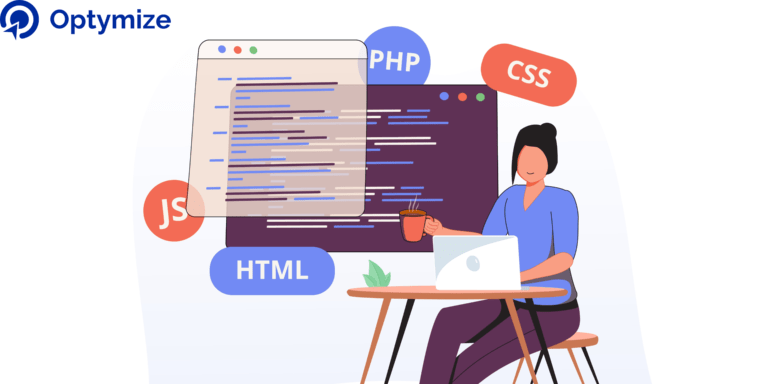Table of Contents
Try booking yourself a set of movie tickets or shopping from an e-commerce app. Even simpler, enter something on the browser. Are you wondering how the content is continually changing and updating with real-time data or amazed at how you’re getting suggestions without typing all the details? It seems like magic doesn’t it? All this is a part of a detailed behind-the-scenes process commonly known as ‘Back-end Development.’ The back-end is all about maintaining a strong online presence while keeping the audience engaged with a unique set of technologies and languages. It powers the product’s growth, making the entire process of online browsing seamless.
Back-end Development and the Role Of A Back-end Developer?
Back-end web development is the backbone of software development. It is the process of writing codes that communicates with the front-end and share relevant information to be displayed on the screen. The interaction happens through a series of requests sent to the back-end servers that store millions of terabytes of data, to help dynamic software maintain its elective presence and keep users interactively engaged.
Back-end Development
also ensures that the software doesn’t crash often or have 404 errors that restrict the overall performance of the page. Now, all this is not powered by AI yet; it is done manually. It is thereby creating a high demand for proficient and experienced back-end developers.
What Is The Role Of A Back-End Developer?
A back-end developer is responsible for creating, maintaining, testing, and debugging the entire back-end. This requires a massive investment of time, patience, and knowledge to master the art of just one language. One language alone is so exhaustingly comprehensive that the back-end engineer must be deeply involved in knowing its entire architecture. Additionally, back-end languages continually modify with upgrades and updates. In such a scenario, back-end developers can’t or rather shouldn’t afford to move to new languages and be a jack of all trades. This would reflect on their knowledge and skills.
How to Hire The Best Developer?

The back-end is critical to your website and the company’s success. Hence, in a digitally evolving world, your decisions can no longer be based on resumes and instincts. Your approach to finding an ideal back-end candidate is backed by a clear understanding of the skills and expertise relevant to both the tech stack and your business.
To help you take a closer look at the necessary skill set that summarizes the role of an ideal back-end software engineer, we’ve divided your hiring process into two parts.
a) What Skills to Look for in a Back-End Developer?
1. Concerning the above diagram, these are the skills required by an ideal back-end developer:
2. Complete command of any one programming language- Java, Go, Python, among others
3. Competent knowledge of various database technologies like MySQL, MongoDB, and Oracle, to name a few
4. A good background in administering servers like Linux, Microsoft IIS, Apache, etc.
5. The ability to manage APIs that are executed across devices such as JSON, AJAX, SOAP
b) Technologies Back-End Developers Should Master
While several technologies contribute to making ideal back-end developers, it is important to recognize the key languages and frameworks that set them apart. Understand their experience and exposure to different technologies to get an accurate picture of your back-end developers’ profile. At the same time, his skill set also has to be relevant to your project and your organizational needs.
The Best Programming Languages of 2020
1. JAVA
One of the most celebrated software programming languages of all time that is used in more than 3 billion devices.
Best Java Frameworks to Know in 2020:
SPRING – This is extremely handy when developing complex applications.
HIBERNATE– When there are multiple databases, this framework makes things speedy, powerful, and easy to scale, modify, and configure.
STRUTS- This framework reduces the processing time as it provides well-organized, easy-to-maintain, extensible, and flexible applications.
GRAILS– This is useful in creating robust and scalable applications for content management systems and e-commerce sites.
PLAY- A credible framework for apps replete with speed, scalability, and performance.
PYTHON
A powerful programming language designed with easy understanding for both beginners and seasoned developers.
Best Python Frameworks to Know in 2020:
Django- This simple, flexible, reliable, and scalable framework ensures a pragmatic and secure development of software.
Pyramid – Fondly known as a finishing-focused lightweight framework that starts small and throughout provides continual performance and quality features.
Flask– It is a lightweight microframework used to build web apps with minimal to no dependencies on external libraries.
GO
Google’s latest development environment and programming language are efficient in developing and optimizing apps.
Best Go Frameworks to Know in 2020:
REVEL- It is easy for building applications owing to its high-productivity, engine-driven, migration-friendly features.
GIN GONIC- An HTTP web framework, 40 times faster than other frameworks, delivering much better performance.
BUGSNAG- Take a proactive approach to monitor and detect errors and improve app quality in real-time.
BEEGO- With an extensive array of intelligent yet straightforward features, a high-performance framework is exceptionally efficient at building and developing applications.
Node JS
With a robust technology stack, Node JS is a universal language for both clients as well as server-side programming. Its unique runtime environment helps build fast, scalable network applications.
Best Node Js Frameworks to Know in 2020:
Express JS – An incredibly fast yet minimal framework used to build high-performing software and unique APIs.
Socket JS – This javascript library enables the creation of real-time applications like chatbots, score tickers, and dashboard APIs, amongst others.
Hapi JS – One of the most preferred robust, stable, and reliable frameworks providing technology solutions to several large-scale websites.
Sails JS – This popular framework is exceptionally compatible with several back-end platforms and is also famous for building data-driven APIs.
RUBY
Ruby is a dynamic and elegant language that is extremely popular among developers owing to its blazing speed in creating new projects with high performance. Since 2002, Ruby has had 1,082 releases.
Best Ruby Frameworks to Know in 2020:
Ruby on Rails- The extensive ecosystem and set of conventions in Rails help speed up the development process while offering high scalability.
Sinatra – With a minimalistic development effort and a straightforward, simple syntax, Sinatra offers what is necessary to create the software.
Padrino – This full-stack Ruby Framework is a fun and interesting way of building highly advanced software applications.
Career Progression For Back-end Developers
This may seem mundane, but the career of a back-end developer progresses within the same technology. They usually upgrade from basic concepts to design patterns to architecture if seeking advancements. It is rare and rather unadvisable for a back-end developer to change technologies and languages with time. However, they do have a close alternative. Depending on their expertise and learning agility, one can take up the challenge and venture into becoming a full-stack developer. Such developers work on both front-end and back-end with a working knowledge of various other areas like Databases, Version Control systems, Designing, etc. For example, becoming a MEAN STACK Developer requires proficiency in M- Mongo Database, E- Express JS, A- Angular JS, and- Node JS.
Another popular choice is LAMP STACK, wherein the foundation is L-Linux, A- Apache, M- MySQL, and P- PHP.

How Optymize helps you to Hire the Best
The types and skills of back-end developers vary greatly. Their skill sets vary from low-level algorithm design to higher-level database work. Hence, one of the best ways to evaluate a back-end engineer’s skills is by conducting a hands-on programming assessment. Optymize conducts specialized back-end developer tests which comprise a variety of coding tests that help solve hiring bottlenecks efficiently. They are available in diverse question types, including MCQs, case study simulators, coding simulators, etc. With a data-driven evaluation methodology, intuitive user interface, and customized reports, recruit the best back-end developer through campus drives or resumes, within stipulated timelines.
1. Ready to Use Pre-Build Tests
The quality and coverage of our technical questions are unmatched as we cover a vast array of roles and skills. A rich repository of 100,000+ Technical Questions for 300+ Skills helps test a coder’s competency at every level comprehensively. You can choose from a set of readily-available standardized tests such as core Java test, Performance testing and load runner, python developer test, Java MySQL developer assessment, and Security Assessment Testing, to name a few from our vast library of Programming Assessments. With a ready-to-use pre-build test set, assessing a coder’s skill instantaneously helps save precious time.
2. Customization at Each Level
In case you are looking for something specific, we get our team of experts to build a customized assessment that you can’t find anywhere. These tailor-made pre-hiring assessments are an ideal filtration process to explore candidates’ desired skill sets without bias, not only for IQ skills but for coding skills as well. Tailored solutions matching organizational objectives with features and applications are offered at every level to assist you in hiring an ideal back-end developer.
3. Extensive List of Simulators
Optimize offers an extensive list of simulators to evaluate a coder’s hands-on experience and capability for the desired role. They enable hirers to give a real project to a coder from a specific domain of software development and evaluate their experience and capability to solve a problem in any desired programming language. These real-world challenges give a true sense of a candidate’s project-building capabilities.
This comprehensive simulator environment is available for
Codelysis: Backend Simulator
Evaluates candidates’ experience and capability to solve a problem in any desired programming language
DB Lysis: Database Simulator
Evaluates candidates’ capability to write correct and optimized SQL queries
FES: Frontend Simulator
Evaluates candidates’ capability to implement web designs and solve problems using frontend technologies
R: Data Science Simulator
Evaluates candidates’ analytical & statistical acumen for data analytics roles
Code Project: Backend+ DB Simulator
Evaluates candidates’ capability to develop console-based applications
Unique Role-Based Coding Platform
If you have an advanced Requirement to assess candidates in a project-based coding environment, Optimize is introducing a first-of-its-kind all-in-one coding assessment platform to assess candidates on project-based, real-world tasks. This highly sophisticated and customizable tool with real-time, insightful reports and auto-evaluation of the code provides best-in-class integrated development environments (IDE) and programming tools which help evaluate their proficiency level. It caters to all major programming roles and supports the most diverse set of technologies. Major roles include:
1. Frontend Development
2. Backend Development
3. Full Stack Development
4. Data Science
5. DevOps
6. Quality Assurance
Future Of Back-end Development
As there are advancements in the creation of software, there is advancement in the selection of the right back-end programming language too. Concurrently, the presence of such exhausting technologies and languages is also intimidating. So what is to be leveraged best to grow your business or regrade a developer?
You must understand that these tools have been there for the last 20 years, and their new versions add more value to them. As a back-end software engineer, it is for you to decide what language best suits your needs. The bigger picture has to be the one that creates top-notch web development and design and meets business objectives seamlessly.
A closer look at each language’s framework suggests there is a vast difference in libraries, APIs, Code Quality, test automation capability, community, popularity, productivity, and future-proofing caliber. Now link this to the fact that the next generation would soon witness an influx of machine learning, data science, and AI. It is, therefore, critical to explore these possibilities and explore how you can sync them with your expertise to create powerful synergies among them. As the competition intensifies, it is time to be smart, pragmatic, and relevant.
Blog credit: Mercer | Mettl







